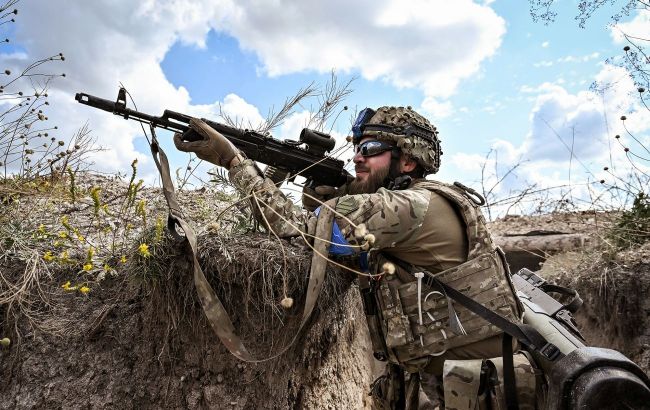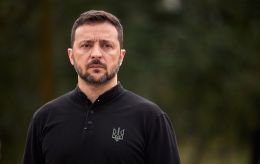Goal is to take Kharkiv into half-ensircled: Details on Russia's new offensive
 Photo: Ukrainian military holding back a Russian offensive in Kharkiv region (Getty Images)
Photo: Ukrainian military holding back a Russian offensive in Kharkiv region (Getty Images)
Last week, Russian forces crossed the border into the Kharkiv region in two additional locations. The enemy is advancing towards Vovchansk and the regional center.
The head of the Center for Military-Legal Research, Oleksandr Musiienko provided more details about the Russian offensive and the threats to Kharkiv and Vovchansk in a commentary to RBC-Ukraine.
Ukrainian Defense Forces' top priority
The Defense Forces' primary task is to push the Russians back to Russia and halt their advance. The Russian troops aim to establish positions on the frontlines, seize Vovchansk, and advance another 2-3 kilometers to the south.
Based on the nature of the events, the enemy is preparing for possible offensive actions in other directions in the Kharkiv region, particularly towards Kozacha Lopan and from Hraivoron to Velyka Pysarivka (a village in the Sumy region).
It can be said that an escalation of combat actions is being prepared not only towards Vovchansk. Therefore, the main task now is to ensure the functioning of a sustainable defense. To restrain the enemy, inflict damage, and prevent their advance. If they see that they can achieve a certain level of success, I have almost no doubt that they will reinforce their troops and continue their advance.
Information about the Russian military grouping
Regarding the number of forces involved in the offensive, Russia is succeeding. However, a small number of troops are currently engaged in combat. The immediate combat group consists of approximately 20,000 soldiers.
Others are located in the Kursk and Belgorod regions. Combined with those already engaged in combat, the total could be up to 40,000.
Perhaps some units of the Defense Forces are showing signs of exhaustion, more than anticipated. However, from the perspective of the quantity of their contingents, I would base only some things on this; they may still be capable of achieving something. Quantity is of secondary importance. Conclusions should be drawn based on the speed of advancement and the effectiveness of actions.
Imitation or offensive?
Undoubtedly, this is a full-scale offensive by Russian forces. The strategic goal is not to fight for Kharkiv or capture the city but to semi-surround the regional center from the north, east, and west directions. This strategic progression is evident.
The question is whether there will be enough strength and resources to achieve the strategic objective. I have doubts. I believe our forces will reinforce and halt the enemy's advance.
If Russian forces achieve success, they will attempt to expand it. The extent to which they can or cannot reach the strategic goal will depend on the speed and volume of aid coming to Ukraine. Fundamentally, it depends on our command's readiness to shift certain forces from the Donbas to the northeast. Then, there is a chance to stop this offensive.
Dilemma for Ukrainian Command
I see Russia's attempts to create a dilemma for the command. What to prioritize defending and where to act? Should we continue defensive operations in Donetsk and redeploy additional forces there? Or should we redirect them to the Kharkiv region?
But the main reason for the Russian offensive is still an attempt to semi-surround Kharkiv. In this sense, the drawing of Ukrainian reserves towards it is undoubtedly one of the elements of a massive operation, the beginning of which we are just observing.
Threats to Vovchansk and Kharkiv
Fighting is taking place directly near Vovchansk. There was even some Russian presence in the city, but we pushed them out. Currently, our forces are doing everything to stop them.
The enemy is trying to establish positions on the frontlines to further advance. There are certainly chances to prevent them from entering Vovchansk. If that fails, they will advance towards Bilyi Kolodyaz south of Vovchansk.
There are risks that Russians may advance towards Lyptsi in the direction of Kharkiv. This area is already practically within range for some artillery. That would be about 25-30 km, which is sufficient for fire impact.
It's difficult to make predictions right now. Everything depends on how quickly our reinforcements arrive, how much weaponry is engaged, how quickly we receive aid, and how resilient our forces are.
If this whole complex of measures is taken, I believe the occupiers won't be able to advance further than 1-2 km. If not, we'll have to fall back to defense lines around Kharkiv. They are quite strong and can hold the enemy at bay for long.
On May 10, Russian forces launched an offensive towards Vovchansk and Kharkiv. Officially, one settlement was reported lost, but DeepState project maps already show two red zones covering a total area of 100 square kilometers.
For more details on what's happening, read RBC-Ukraine's article "Demonstration or offensive - What Russia plans starting fights in Kharkiv region."

